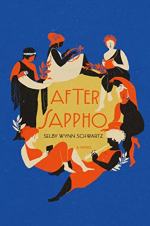|
This section contains 920 words (approx. 3 pages at 400 words per page) |

|
After Sappho Summary & Study Guide Description
After Sappho Summary & Study Guide includes comprehensive information and analysis to help you understand the book. This study guide contains the following sections:
This detailed literature summary also contains Quotes and a Free Quiz on After Sappho by Selby Wynn Schwartz.
The following version of this book was used to create this guide: Schwartz, Selby Wynn. After Sappho. 2022. Liveright Publishing Corporation, 2023.
Selby Wynn Schwartz’s novel After Sappho is written from the first-person plural perspective; she employs a collective narrator throughout. Schwartz utilizes the past tense in the novel. After Sappho is, primarily, a collection of often nonlinear fragments. For clarity’s sake, this guide presents the novel in a more linear order.
In the prologue, the collective narrator describes Sappho, the ancient Greek poet whose work—often focusing on love and desire between women—survives only in fragments. In the late nineteenth century, Lina Poletti struggles against misogyny to study at an Italian university. During the same time period, a man rapes Rina Faccio (soon known as Sibilla Aleramo); her father later forces her to marry that same man. Italian law permits the effective enslavement of women. Anna Kuliscioff, an Italian doctor and revolutionary, advocates for socialism. Sibilla publishes Una donna, a radical feminist novel, and begins a romance with Lina, now a young poet. The collective “we” narrator notes that they—namely lesbians and feminists—hope to become Sappho herself. The narrator then discusses the influence of Henrik Ibsen’s A Doll House on Sibilla. Like the protagonist in the play, Sibilla leaves her heterosexual marriage. The characters in her writing often blur the societal line between men and women.
In the late nineteenth century, a young Virginia Stephen (later Virginia Woolf) writes in her journal about small episodes in her life. The narrator invokes Cassandra, the prophetess whose dark prophecies were never believed. Virginia studies at a college and, later, publicly defends the work of female writers. In Chapter Six, the narrator describes the romance between the writer Natalie Barney and the painter Romaine Brooks. Natalie, who hosts a literal salon at her home in Paris, also has a relationship with the poet Renée Vivien. Natalie’s salon becomes an important hub for lesbians, sapphists, and feminists. The women in Natalie’s salon discuss art and politics; they all deeply admire Sappho. In 1904 Natalie and Renée visit the island of Lesbos, Sappho’s onetime home. To Natalie’s despair, Renée dies in 1909. Sibilla travels to Paris and tells the lesbian community there about Lina. The narrator describes the Italian actresses Eleonora Duse and Giacinta Pezzana, who challenge traditional gender roles through their work. Lina and Eleonora begin a romance. Towards the end of her life, Eleonora passionately argues for women’s equality in Italy. At the turn of the twentieth century, Eva Palmer performs the work of Sappho and later becomes romantically involved with Natalie. Sarah Bernhardt teaches Eva about the potential power of acting. Eva becomes an important part of the lesbian community in Paris.
The dancer Isadora Duncan travels to Greece, where she plans to build a house. Isadora, Penelope Sikelianos, and their respective brothers hope to build a school dedicated to classical Greek culture. Eva meets Penelope and eventually marries her brother. Romaine and Natalie build a villa for themselves in the South of France, where they each work on their art. In Paris, the community of lesbians walk between Natalie’s home and that of Gertrude Stein. The Irish artist Eileen Gray begins designing screens and furniture. Italian politicians, through racism and sexism, seek to protect the apparent purity of the Italian race. Oscar Wilde writes a play for Sarah, but she eventually refuses the role. Eleonora, in turn, spurns the role. Ida Rubinstein accepts the part, but Wilde dies before the premiere. Isadora’s two children die in a car accident, and she begins a romance with Eleonora. Both Natalie and Eleonora form organizations dedicated to furthering women’s rights. Europe descends into World War I.
The lesbian community discusses the future of their movement. Eileen, Romaine, and Ida work as ambulance drivers in the war. Lina enters into a relationship with the countess Eugenia Rasponi. After the war, the various lesbian artists think of new forms through which to express their visions of the world. Vita Sackville-West writes a book to explain her marriage; she maintains romantic relationships with women, while her husband is married to another man. Eileen opens a gallery with glass floors through which visitors can observe her workshop. The writer Radclyffe Hall, herself a lesbian, sometimes criticizes the movement. Romaine paints portraits of many of her friends, lovers, and comrades. One evening, Romaine’s friends find a stunning self-portrait of her. Fascism begins to overtake Italy; Lina writes a manifesto in protest. The novelist Colette encourages her peers to conceptualize readers as lovers. Ada Bricktop Smith opens a nightclub in Paris. Virginia proposes entirely new theories of the novel. She and Vita begin a romantic relationship. Lina travels to Crete to research ancient, progressive civil codes.
In the early 1900s, Virginia and Vita publish their work through Hogarth Press. Eugenia warns Lina, still on Crete, that the Italian authorities have raided her home. Eileen builds a house called E.1027 in France. In Chapter 18, the narrator describes Berthe Cleyregue, Natalie’s housekeeper, who wrote vivid accounts of Natalie and her many guests. Lina disappears. Eva hosts a revival of the Delphi Festival in 1927. As fascism rises, all conceptions of literary genre seem to disintegrate. Many of the lesbian artists publish autobiographies and memoirs; Virginia advocates for a new kind of feminist biography. Virginia works on Orlando, a fictional biography inspired by Vita. In the afterword, the narrator discusses the importance of Lina.
Read more from the Study Guide
|
This section contains 920 words (approx. 3 pages at 400 words per page) |

|



